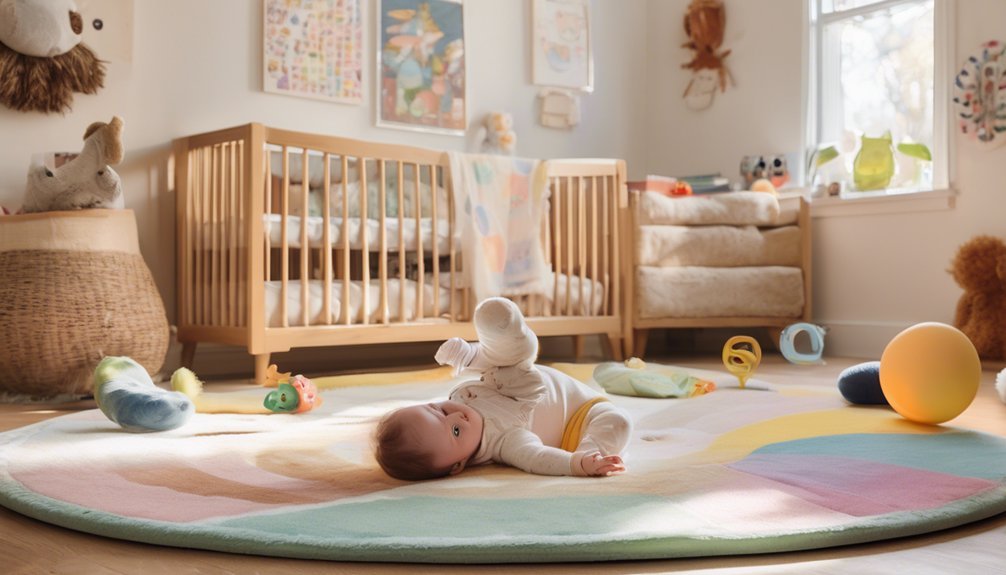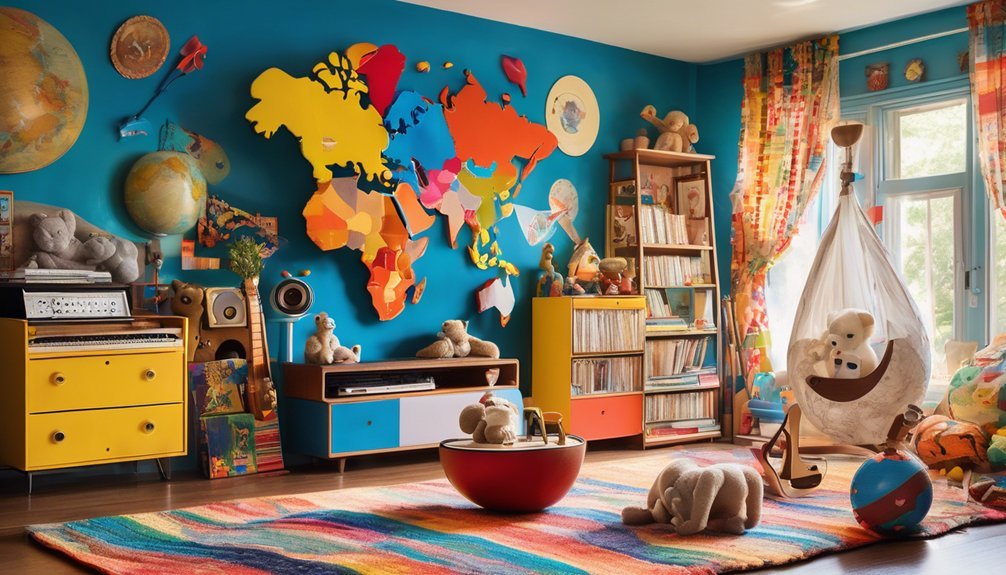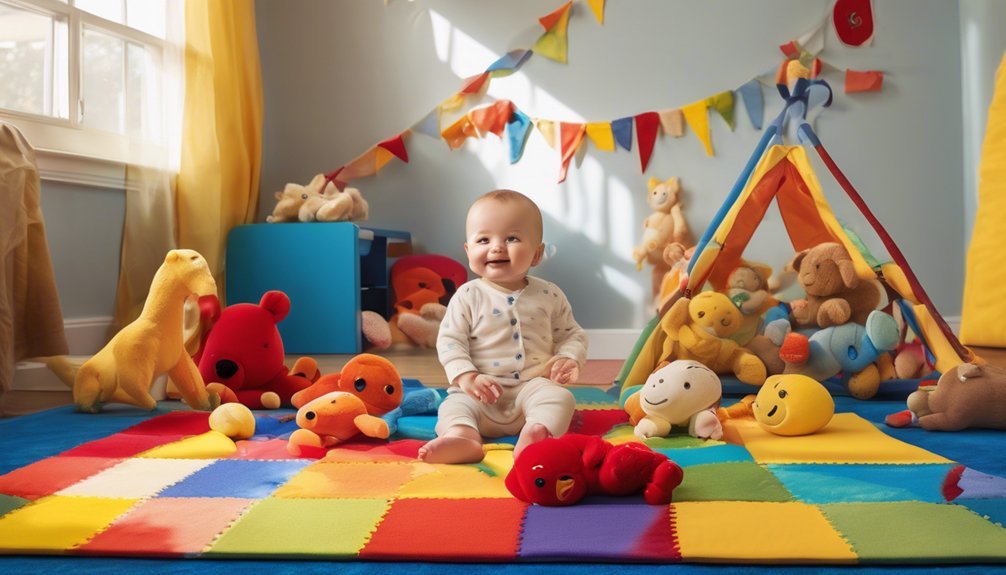Just as Mozart believed in the powerful influence of music on the mind, you too can harness this potential for your baby. Integrating music into their daily routine can support their development in numerous ways. From soothing lullabies to interactive songs, each selection plays a role in fostering growth. So, how do you curate the perfect playlist that balances tranquility and stimulation? Let’s explore some ideas together.
Key Takeaways
- Create a balanced playlist mixing soothing lullabies, upbeat nursery rhymes, and colorful character songs to promote relaxation, movement, and learning.
- Include classic pieces by composers like Mozart to enhance cognitive development and memory retention in babies.
- Incorporate interactive songs that encourage participation, boosting language skills and fostering joyful connections through movement and rhythm.
- Rotate selections regularly to keep the playlist fresh, ensuring engagement with different tempos and styles for varied moods.
- Use nature sounds alongside music for calming moments, helping to soothe babies during relaxation or sleep times.
The Importance of Music in Early Development

As you introduce your baby to the world of music, you’re not just filling their environment with pleasant sounds; you’re also laying the foundation for their cognitive and emotional development.
Engaging with music stimulates your baby’s senses, enhancing sensory stimulation that’s crucial for cognitive growth. When you sing or play music together, you create moments of emotional bonding that strengthen your connection.
Music encourages creative expression, allowing your little one to explore their feelings and ideas in a joyful way. Research shows that early musical experiences can lead to improved literacy skills and better emotional regulation.
Soothing Lullabies for Sweet Dreams
Introducing soothing lullabies into your baby’s bedtime routine can significantly enhance their sleep experience. These gentle melodies create a calming atmosphere, easing your little one into a peaceful slumber.
Research shows that music can lower stress and foster relaxation, making it an essential component of bedtime.
Here are some classic lullabies to consider:
- “Brahms’ Lullaby”
- “Twinkle, Twinkle, Little Star”
- “Rock-a-Bye Baby”
- “You Are My Sunshine”
- “Hush, Little Baby”
Incorporating these songs can transform your evening rituals into cherished moments of intimacy and connection.
As you sing or play these lullabies, you’ll not only soothe your baby but also create lasting memories that enhance bedtime routines.
Enjoy this precious time together!
Upbeat Nursery Rhymes to Encourage Movement
To help your baby develop motor skills and coordination, incorporating upbeat nursery rhymes into playtime can be incredibly effective. Energetic melodies and fun choreography motivate little ones to participate in dance activities and movement games. These engaging tunes not only entertain but also encourage physical activity, promoting healthy development.
Here’s a quick reference table for some fantastic nursery rhymes:
| Nursery Rhyme | Dance Activity | Movement Game |
|---|---|---|
| “Hickory Dickory Dock” | Climb like a mouse | Run in place |
| “The Wheels on the Bus” | Roll arms like wheels | Spin and sway |
| “If You’re Happy and You Know It” | Clap and stomp | Jump with excitement |
Incorporating these playful songs into your routine helps foster a love for movement in your baby.
Classical Music for Cognitive Enhancement

While upbeat nursery rhymes spark movement and energy, classical music offers a different kind of enrichment for your baby’s development. Research shows that listening to classical compositions can provide significant cognitive benefits, enhancing your little one’s brain function and emotional growth.
Here are some ways classical music can aid in cognitive enhancement:
- Stimulates brain development
- Improves memory retention
- Encourages focus and attention
- Fosters creativity and imagination
- Reduces stress and anxiety
Consider introducing your baby to works by renowned classical composers like Mozart, Bach, or Beethoven. Their intricate melodies and harmonies create an immersive auditory environment that nurtures your child’s blossoming mind.
Embrace these moments together, and enjoy the enriching journey that music brings to your family.
Interactive Songs for Language Development
As your baby engages with interactive songs, you’ll notice a remarkable boost in their language development. These delightful musical experiences encourage not just listening, but also participation.
Incorporating interactive storytelling into your routine can make a world of difference. When you sing songs that invite clapping, dancing, or simple responses, you’re creating a rich environment for language skills to flourish.
Musical games, like “The Wheels on the Bus” or “Head, Shoulders, Knees, and Toes,” help your little one connect words with actions, enhancing vocabulary and comprehension. Plus, the joy and laughter shared during these activities strengthen your bond, making learning feel effortless.
Nature Sounds to Stimulate Curiosity
Building on the joy of interactive songs, introducing your baby to nature sounds can spark their curiosity in exciting ways.
Nature sounds not only soothe but also engage your baby’s senses, helping them connect with the world around them. Here are a few sounds to consider:
- Bird songs: The varied melodies can intrigue and captivate.
- Ocean waves: The rhythmic crashing creates a calming atmosphere.
- Rustling leaves: This gentle sound encourages exploration of the environment.
- Rainfall: The soft patter can promote relaxation and focus.
- Crickets chirping: Their nighttime symphony can inspire wonder about the outdoors.
Incorporating these sounds into your baby’s routine can foster a love for nature and stimulate their curiosity, enriching their developmental journey.
World Music for Cultural Exposure

Introducing your baby to world music can open their ears to diverse cultures and sounds, enriching their auditory experiences. By exposing your little one to global rhythms, you’re not just introducing melodies; you’re fostering an appreciation for cultural diversity.
Research shows that early exposure to various musical traditions enhances cognitive development and emotional understanding. Try incorporating music from Africa, Asia, and Latin America into your baby’s playlist. The vibrant beats and unique instruments can spark curiosity and joy.
As they listen, they’ll develop a sense of connection to the world around them, cultivating empathy and appreciation for different cultures. Remember, every song tells a story, and your baby is ready to explore them all.
Family Sing-Alongs for Bonding
When you gather your family for sing-alongs, you’re not just having fun; you’re creating lasting memories and strengthening bonds. Engaging in family harmonies fosters a sense of belonging and joy.
Plus, it’s a wonderful way to introduce musical games that keep everyone entertained and connected. Here are some ideas to enhance your sing-along experience:
- Choose a mix of classic and contemporary songs.
- Incorporate hand movements or dance to keep it lively.
- Create a theme night, like Disney or holiday favorites.
- Encourage everyone to take turns picking songs.
- Introduce simple instruments for added fun.
These activities promote emotional closeness, enrich communication, and allow your family to share laughter and love through music.
Cherish these moments!
Instrumental Tracks for Relaxation
As you seek moments of tranquility amidst a busy day, instrumental tracks can offer a soothing escape for both you and your baby. Research shows that ambient melodies and calming rhythms can significantly reduce stress levels, creating a peaceful environment.
These gentle sounds not only help in calming your little one but also provide you with a much-needed respite. Consider creating a playlist filled with soft piano, nature-inspired sounds, or light strings to guide your relaxation moments.
As you listen, you might find that these tracks enhance your bonding time, allowing you both to unwind together. Embrace this opportunity to nurture calmness and connection, transforming your daily routine into a serene experience for both you and your baby.
Playful Songs That Teach Colors and Shapes

After enjoying some calming instrumental tracks, it’s time to shift gears and engage your baby’s curiosity with playful songs that teach colors and shapes.
These engaging tunes not only entertain but also foster learning through repetition and vivid imagery. Songs featuring colorful characters can make the experience even more delightful!
Here are some great options to consider for your playlist:
- “The Color Song” – A cheerful tune highlighting different colors.
- “Shape Up” – An upbeat song focusing on various shapes.
- “Rainbow Colors” – A vibrant exploration of colors in nature.
- “Shapes in My World” – A fun narrative about shapes around us.
- “Colorful Friends” – A catchy song featuring colorful characters teaching colors.
These playful songs will surely brighten your baby’s day while enhancing their learning experience!
Rhythmic Beats for Motor Skills Development
Incorporating rhythmic beats into your baby’s playlist can significantly enhance their motor skills development, as these lively tunes encourage movement and coordination.
Rhythm exercises, like clapping or tapping along to the music, can help your little one improve beat coordination. As they bounce, sway, or crawl to the rhythm, they’re not just having fun; they’re building essential physical skills.
Research shows that engaging with music can stimulate brain development, making it a perfect tool for nurturing your baby’s growth.
Creating Your Own Personalized Playlist
Creating a personalized playlist for your baby can enhance their musical experience and support their development. Through thoughtful playlist curation, you can create a comforting and stimulating environment.
Here are some tips for making your personalized selections:
- Choose a mix of genres: Incorporate classical, jazz, and lullabies for variety.
- Include family favorites: Share songs that hold special meaning for your family.
- Consider tempo and rhythm: Select tracks with varying tempos to engage different moods.
- Add nature sounds: Integrate gentle sounds like rain or ocean waves for relaxation.
- Rotate selections regularly: Keep the playlist fresh to maintain your baby’s interest.
Frequently Asked Questions
How Can I Introduce My Baby to Different Music Genres?
To introduce your baby to different music genres, play a variety of tunes daily. Rotate genres like classical, jazz, and folk. This music exposure fosters genre diversity, enriching their auditory experience and nurturing their developing mind.
What Instruments Are Best for Babies to Explore?
Imagine your baby’s tiny fingers dancing over colorful musical toys. Instruments like maracas, xylophones, and tambourines spark sensory exploration, inviting joy and creativity. These tools nurture curiosity while fostering a love for music in their early years.
Are There Any Music Apps for Babies?
Yes, there are great music streaming apps for babies! Look for those featuring educational songs that engage their senses. These apps can foster bonding and stimulate early learning while you both enjoy delightful melodies together.
How Loud Should Music Be for Infants?
You should keep music volume soft for infants, ideally below 50 decibels. Their sound sensitivity makes loud noises overwhelming, so gentle melodies create a soothing environment, promoting comfort and security for your little one.
Can Music Help With My Baby’s Sleep Routine?
You’d think sleep’s all about silence, right? Actually, calming melodies can transform your baby’s sleep environment. Research shows soothing tunes help establish a routine, promoting relaxation and a peaceful slumber for both of you.
Conclusion
By weaving soothing lullabies for peaceful nights, upbeat nursery rhymes for joyful movement, and playful songs for learning, you’ll create a rich musical tapestry that nurtures your baby’s development. With every note, you’re fostering language skills, enhancing cognitive abilities, and encouraging motor skills. Embrace the magic of music, keep the playlist diverse, and watch your little one thrive in a harmonious world. Together, you’ll explore, learn, and grow, one song at a time.




